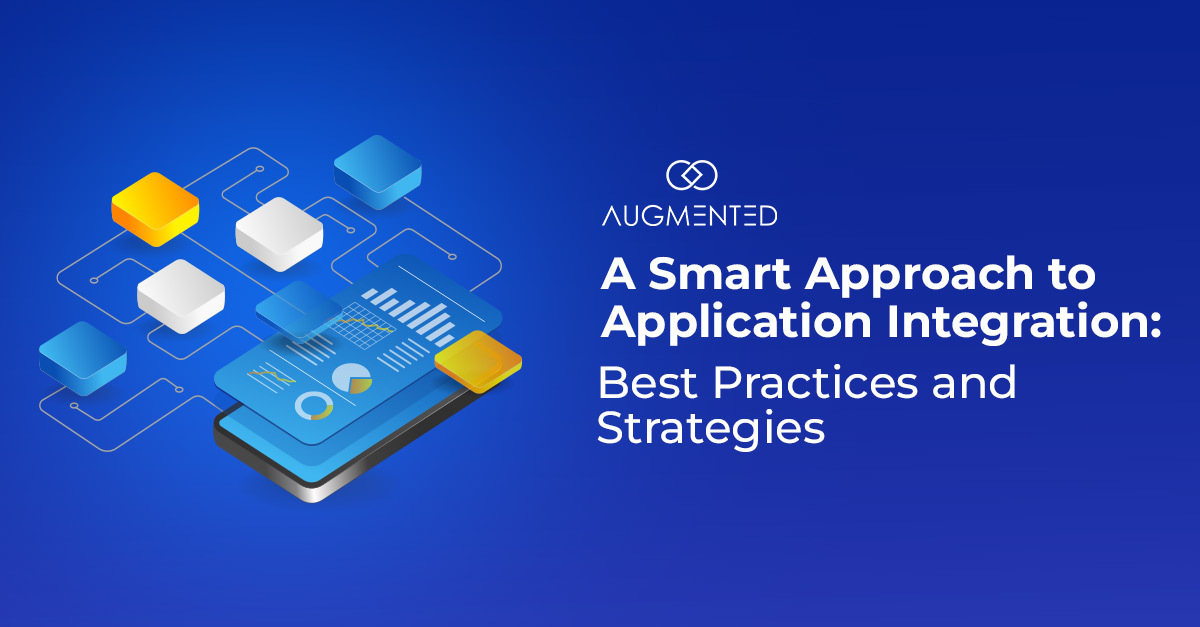Software has become a key part of modern businesses, and we need many of them to perform different business functions.
However, managing all of them can give you headaches daily. You don’t want to spend half of your day juggling, don’t you?
That’s where application integration comes in.
How do you ensure your business’ application integration is done to its full potential? Well, you read this blog post.
Let us uncover the best practices and proven strategies so that you can best leverage application integration. Let’s dive in!
What is Application Integration? Why is It Important?
Application integration is a process of coinciding multiple applications through a common platform, enabling seamless communication and data sharing.
Businesses these days rely on multiple applications to perform different tasks. All the application works in silos. Result? It leads to inefficient processes and errors.
Application integration streamlines the tasks, reduces errors, and increases business and organization productivity.
For instance, you buy clothes from an online store. What does integration of applications do? It helps the online clothing store to link their website, inventory management, and payment processing system.
When you order clothes from this online store, the website automatically updates the inventory and processes your payment. This assures that the entire process is seamless, without any hiccups.
Inarguably, every application works great individually. However, the integration of applications plays a vital role in connecting the on-premise legacy systems with modern cloud-based enterprise applications.
In today's tech landscape, integration is essential for optimizing organizational efficiency and reducing costs.
Benefits of Effective Application Integration Services
Application integration is a game-changer for businesses as they can streamline operations more efficiently, improve data flow, and enhance productivity.
Let's dig deeper to know the five key benefits of application integration services.
Benefit 1: Information Sharing
As the name suggests, the application integration software has the ability to share real-time data between various software. It bridges the gap between different applications by ensuring consistency across your organization.
Example: Application Integration for a Retail Store
A retail store shares information between its e-commerce platform, inventory management system, and customer relationship management (CRM) software. How?
- A customer places an order on the website. The website shares this information with the inventory system. It checks the stocks and provides real-time updates to the CRM system.
- The CRM system updates the customers for delays or refunds. As well as it stores order history and preferences for recommendations.
Thus, with application integration, information sharing among these systems makes the process smooth, efficient, and customer-friendly.
Benefits 2: Process Automation
Integration of applications automates the entire process (as in the example above). It eliminates mundane data entry tasks by connecting different applications. Thus allowing employees to focus on value-added work.
The overall benefit of process automation is that it enhances efficiency and productivity for any organization.
Example: Application Integration for a Company’s HR System
Say a company wants to automate its employee onboarding process. Application integration helps the HR system collect employee details, set up payroll, and grant access to related systems. How?
- So, when an employee gets hired, the automated HR system shares the information with the payroll system, IT system, facilities department, and more.
- Payroll systems update salary-related details. The IT system creates a user account with necessary access permissions. The facility department arranges for desks and other equipment for the new employee.
Thus, process automation accelerates the onboarding process by enhancing efficiency and minimizing errors.
Benefit 3: Reduces Time and Saves Money
Application integration offers time savings and cost-saving advantages to an organization. It helps eliminate duplicate data and reduces operational costs.
Automating workflow helps employees save from task redundancy and provides better data management.
Example: Application Integration for a Small Business
Say a small business wants to grow its business by focusing more on customers. They do so by improving their sales and marketing. Application integration can help the business do so cost-effectively and in less time. How?
- They integrate their CRM system with the marketing system. The CRM system updates customer information when a potential customer shows interest in a product or service.
- The customer details are added to the list of sales leads. Which the marketing team looks at and automatically sends follow-ups to nurture the leads.
This reduces manual data entry, downsizing the dependency on manual work and lowering labor costs.
Benefit 4: Accurate and Consistent Data
Manual data transfer from one system to another often leads to errors and inconsistencies. Of course, it’s natural. Human errors are prone to happen. Solution? Application Integration.
Application integration accurately and consistently exchanges information between applications with minimal risk of data discrepancies.
Example: Application Integration for a Shipping Company
A shipping company integrates its order management and delivery tracking systems to ensure data consistency and accuracy. How?
- As a customer places an order for a shipment, the order management system shares customer and order details with the delivery tracking system.
- The delivery system does its tasks with the information and provides real-time updates to the customers. If there are changes to the delivery, the delivery system informs the order management system, which notifies the customers.
With application integration, manual errors are eliminated, ensuring that the data shared over the systems is accurate and consistent.
Benefit 5. Enhanced Customer Experience
Ensuring a satisfactory customer experience is essential to retaining customers and gaining a competitive edge in today's market. No one would want to visit your organization's platform if they had to open different applications for a single task.
Streaming those applications together using application integration enhances customer experience.
Example: Application Integration for a Clothing Website
A clothing website integrates with its inventory management system for an enhanced customer experience. How?
- On a website, when a customer selects a product, the website verifies its availability by checking the inventory system.
- If the product is available, the customer may process to add it to the cart; otherwise, an "out of stock" message pops up on the website's screen. After the purchase, the inventory system updates the stock on the website.
A positive customer experience increases customer satisfaction and loyalty.
Best Practices for Successful Application Integration
1. Research
You should know what you want to achieve. Doing proper research is like doing your homework before a project. For a successful application integration, gathering information is crucial.
So, ask these questions to yourself as you start your research.
- Integration Objective: Which integration approach is most suitable for your requirements? Which approach aligns best with your organization's objective?
- Understanding of the System: Learn about the way the system works. Are you aware of its technical requirements?
- Basics of Application Integration: What is API, and how do APIs work?
- Resource Planning: What is your budget and timeline? Who are the stakeholders?
- Effectiveness of the Integration: How will you measure the success of your integration, and what will be the challenges?
2. Application Integration Tools and Platforms
Familiarize yourself and experiment with various application integration tools. Why? Because you should know which tool suits your requirements or business needs. So, to work with an integration system, you need to gain practical knowledge and experience.
These are a few application integration tools you can use - Boomi, Celigo, and IBM. Another solution is to hire an application integration expert.
3. Stay Updated
It would help if you connected with as many people as possible to stay updated with the latest technological trends and advances.
So, network with other professionals from similar fields, participate in workshops, and attend events. You can likewise attend webinars and conferences as well as follow industry blogs.
4. Data Quality and Security
To prevent errors and maintain reliable information, you need to ensure that the quality of your data is accurate and consistent. Moreover, the shared or integrated data with other applications should be securely transferred.
5. Seek Feedback, Monitor and Test
Ask for feedback from mentors and industry experts. Use the feedback to implement necessary changes.
Furthermore, use monitoring and error-handling mechanisms to detect the issues early, diagnose the problems and implement solutions.
Last Advice: Hire Application Integration Experts
In today's swiftly changing digital domain, hiring an application development and integration expert is like hiring a tech-savvy magician for your business. They can be beneficial for several reasons.
- They Know What They’re Doing: The experts have in-depth integration knowledge. They know how to integrate various systems and applications. Moreover, they streamline the processes and help prevent costly errors.
- Custom Solutions and Scalability: They assist you in tailoring the integrations according to your business requirements, guaranteeing progress and growth.
- Quick Fixes and Security: The hallmarks of expert service: they quickly resolve issues and maintain data security as they’ve done hundreds of times.
- Compliance and Support: Experts ensure all connections comply with industry regulations and standards. They also provide continuous support and maintenance.
- ROI Maximization and Strategic Insights: Integration experts offer value advice for staying competitive and optimizing technology investments.
We at Augmented revolutionize the IT industry by simplifying and enhancing how businesses utilize technology.
With over 15 years of industry experience, Augmented Systems has over 60 projects exceeding customers' expectations. Moreover, more than 40 active clients rely on us for their IT needs.
We are committed to providing exceptional quality, true leadership, and a nurturing collaborative environment. We take ownership and accountability seriously.
You can trust us to uphold the highest standards of integrity and stay updated with the latest technological achievements.
Final Words
In this digital era, where data flows freely and technology is evolving quickly, application integration is not merely a convenience but a necessity. Organizations worldwide have adopted it, and you should, too.
At Augmented Systems, our team of experts is dedicated to providing top-notch software development and application integration services. Unlock the full potential of your organization and contact us if you need help with your application integration needs.





